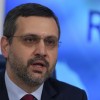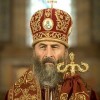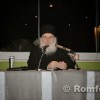|
FEAST OF THE ASCENSION OF
OUR LORD AND SAVIOR
JESUS CHRIST
Introduction
The Feast of the Ascension of our Lord God and Savior
Jesus Christ is celebrated each year on the fortieth day after the Great and
Holy Feast of Pascha (Easter). Since the date of Pascha changes each year, the
date of the Feast of the Ascension changes. The Feast is always celebrated on a
Thursday.
The Feast itself commemorates when, on the fortieth day after His
Resurrection, Jesus led His disciples to the Mount of Olives, and after blessing
them and asking them to wait for the fulfillment of the promise of the Holy
Spirit, He ascended into heaven.
Biblical Story
The story of the Ascension of our Lord, celebrated as
one of the Twelve Great Feasts of the Church, is found in the book of the Acts
of the Apostles 1:3-11. It is also mentioned in the Gospels of Mark (16:19) and
Luke (24:50-53). The moment of the Ascension is told in one sentence: “He was
lifted up before their eyes in a cloud which took Him from their sight” (Acts
1:9).
Christ made His last appearance on earth, forty days after His Resurrection
from the dead. The Acts of the Apostles states that the disciples were in
Jerusalem. Jesus appeared before them and commanded them not to depart from
Jerusalem, but to wait for the “Promise of the Father”. He stated, “You shall be
baptized with the Holy Spirit not many days from now” (Acts 1:5).
After Jesus gave these instructions, He led the disciples to the Mount of
Olives. Here, He commissioned them to be His witnesses “in Jerusalem, and in all
Judea and Samaria, and to the end of the earth” (Acts 1:8). It is also at this
time that the disciples were directed by Christ to “go and make disciples of all
nations, baptizing them in the name of the Father and the Son and the Holy
Spirit” (Matthew 28:19). Jesus also told them that He would be with them always,
“even to the end of the world” (Matthew 28:20).
As the disciples watched, Jesus lifted up His hands, blessed them, and then
was taken up out of their sight (Luke 24:51; Acts 1:9). Two angels appeared to
them and asked them why they were gazing into heaven. Then one of the angels
said, “This same Jesus, which is taken up from you into heaven, shall so come in
like manner as you have seen Him going into heaven” (Acts 1:11).
 |
| 1. Christ ascending into heaven in a mandorla. |
Icon of the Feast
The icon of The Ascension of Our Lord is a joyous icon. It is painted with
bright colors. Christ is shown ascending in His glory in a mandorla 1. A
mandorla is a design which is almond-shaped or round. Inside the mandorla is the
figure of a holy person. Christ blesses the assembly with His right hand 2. In
His left is a scroll. The scroll is a symbol of teaching 3. This icon shows that
the Lord in heaven is the source of blessing. In addition, Jesus is the source
of knowledge. The icon reminds us that Christ continues to be the source of the
teaching and message of the Church, blessing and guiding those to whom He has
entrusted his work.
 |
 |
2. Christ blessing with His right hand
those who are witnessing His glorious Ascension into heaven (detail). |
3. The Scroll in Christ’s left hand
(detail). |
The Theotokos occupies a very special place in this icon 4. She is in the
center of the icon, immediately below the ascending Christ. The gesture of her
hands is gesture of prayer. She is clearly outlined by the whiteness of the
garments of the angels 5. The Theotokos is depicted in a very calm pose. This is
quite different from the appearance of the Disciples. They are moving about,
talking to one another and looking and pointing towards heaven. The entire
group, the Theotokos and the disciples represent the Church.
 |
| 4. The Theotokos amongst the Angels and Apostles
|
The icon of the Ascension includes some who did not witness the Ascension.
St. Paul is shown to the left of the Theotokos, but we know that he was not
present at the Ascension 6. At that time, St. Paul did not yet believe in Jesus.
But he became a Christian and one of the greatest Apostles and missionaries of
Church.
 |
 |
| 5. The Theotokos (detail). |
6. Saint Paul, who did not witness
Christ’s Ascension, is depicted in the icon (detail). |
The icon expresses the sovereignty of Christ over His Church; He is its Head,
its guide, its source of inspiration and teaching; it receives its commission
and ministry from Him, and fulfils it in the power of the Holy Spirit.
Orthodox Christian Celebration of
the Feast of the Ascension
This Feast of our Lord is celebrated with the Divine Liturgy of Saint John
Chrysostom, which is conducted on the day of the Feast and preceded by the
Matins service. A Great Vespers is conducted on the evening before the day of
the Feast. Scripture readings for the Feast are the following: At Vespers: Isaiah 2:2-3, 62:10-63:9; Zechariah 14:1,4,8-11. At the Orthros (Matins) Mark 16:9-20; At the Divine Liturgy: Acts 1:1-12; Luke 24:36-53.
Hymns of the Feast
Apolytikion (Fourth Tone)
O Christ our God, You ascended in Glory and
gladdened Your disciples by the promise of the Holy Spirit. Your blessing
assured them that You are the Son of God, the Redeemer of the world.
Kontakion (Plagal of the Second Tone)
O Christ our God, upon fulfilling
Your dispensation for our sake, You ascended in Glory, uniting the earthly with
the heavenly. You were never separate but remained inseparable, and cried out to
those who love You, “I am with you and no one is against
you.”
|
![]()
![]()

























